
Official Edgar Rice Burroughs Tribute and Weekly Webzine Site
Volume 8093


Did
Tarzan Ever Kill a Woman?
by Alan Hanson
In
Edgar Rice Burroughs’ Tarzan
stories,
the ape-man certainly was a prolific killer of his fellow men. He
didn’t kill
indiscriminately, though. Burroughs made it clear that when Tarzan
killed men,
they usually “had it comin’.” (That wasn’t always the case, though.
Except for
Kulonga, the natives that the young Tarzan killed just to get their
weapons in Tarzan of the Apes were
innocents.
Tarzan later regretted those slayings.)
The
topic here, though, is
whether or not
Tarzan ever killed a woman. There is a legal term for such an action.
It’s
“femicide,” defined
as the intentional
killing of a
woman with a “gender-related motivation.” In other words, “killing a
woman because she was a woman.” Tarzan was
innocent of that crime. However, he could be cited for causing the
death of women
for other reasons, such as in self-defense or in protection of his
family and
friends. Also, Tarzan fought in both world wars, when the killing of
enemy
women might become an unfortunate outcome in battle.
The
goal here, though, is to determine if Tarzan of the Apes/John
Clayton, Lord Greystoke ever willingly caused the death of a woman in
Edgar
Rice Burroughs’ tales of the ape-man.

Early Encounters With
Women
During
the period when Tarzan
was
transitioning from a creature of the wild to a civilized man, he
struggled to
reconcile his in-bred feelings about women with how he observed their
fear of
men in the civilized world. He voiced his confusion on the topic in a
conversation with Olga de Coude in The
Return of Tarzan.
“It
does not seem right that women should fear men. I am better acquainted
with the
jungle folk, and there it is more often the other way around. No, I
cannot
understand why civilized women should fear men, the beings that are
created to
protect them. I should hate to think that any woman feared me.”
Throughout
the early Tarzan
tales, the
hybrid ape-man/English lord indeed was a protector of women, first of
Jane from
the dastardly Russian, Nickolas Rokoff, in The
Beasts of Tarzan. Then, in The Son
of
Tarzan, he tried to shield Meriem from the impure advances of
the
evil
Swede, Sven Malbihn, and the less than honorable English gentleman,
Morison
Baynes. In wasn’t until later, in Tarzan
the Untamed, that Burroughs’ tested Tarzan’s belief that men
are
the
protectors of women. Throughout the story, ERB gave Tarzan a strong
desire to
kill a certain woman.
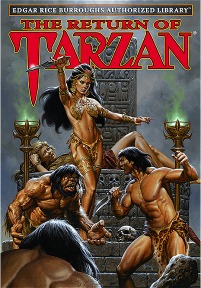


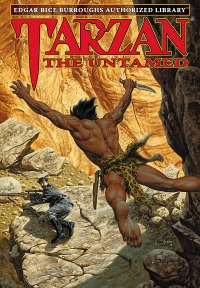
Tarzan
Planned to Kill Bertha Kircher
ERB
set up the conundrum thus.
At the
outset of World War I, Tarzan became convinced that, while he was away,
a group
of German soldiers attacked his African home, killed his wife Jane, and
burned
her body beyond recognition. Tarzan immediately vowed to find and kill
the
German who had murdered Jane. Then … “After he had accounted for him he
would
take up the little matter of slaying all Germans who crossed his path,
and he
meant that many should cross it.”
Soon,
one who passed his path
was a woman —
the German spy Bertha Kircher. Tarzan knew she was a German spy
because, “He
had seen her at General Kraut’s headquarters in conference with the
German
staff and again he had seen her within the British lines masquerading
as a
British officer.” Later, when Tarzan saw her wearing the locket that
had been
taken from his dead wife’s neck, it further inflamed his hate for her
and his
resolve to kill her.
Tarzan
first had an opportunity
to affect
Bertha’s death by not interfering when he came across a lion attacking
her.
“What was she but a hated German and a spy besides?” was his initial
thought.
Then, after it occurred to him that the British military would like to
question
her, he stepped in to save her from the lion.
He
was still determined to kill
her
eventually.
“She
was very beautiful — that was undeniable; but Tarzan realized her
beauty only
in a subconscious way. It was superficial — it did not color her soul
which
must be black as sin. She was German — a German spy. He hated her and
desired
only to compass her destruction; but he would choose the manner so that
it
would work most grievously against the enemy cause.”
However,
when Tarzan noticed
Bertha was
wearing Jane’s locket, he angrily threatened to kill her on the spot.
“Tell me
who gave it to you or I will throw you back to Numa,” he raged. “I was
going to
take you to headquarters. They would dispose of you there; but Numa can
do it
quite as effectively. Which do you prefer?”
Tarzan
Realized He Couldn’t Kill a Woman
Bertha
later knocked Tarzan
unconscious and
fled. Later he confronted her again behind German lines after she
watched him
brutally kill a German officer. In the interim, he had come to the
realization
that he could not kill Bertha Kircher in the same way. “It would be
difficult
to take you back from here and so I was going to kill you, as I have
sworn to
kill all your kind,” he told her. “But you were right when you said
that I was
not such a beast as that slayer of women. I could not slay him as he
slew mine,
nor can I slay you who are a woman.”
To
be sure, Tarzan still wanted
Bertha
dead. While he couldn’t bring himself to kill her directly, he hoped
another
opportunity would arise to make it happen in a way that his conscience
could
sanction. That opportunity came when he discovered that a band of
native German
soldiers had abducted Bertha.
“Tarzan
of the Apes was haunted by the picture of a slight, young girl being
shoved and
struck by brutal Negresses, and in imagination could see her now camped
in this
savage country a prisoner among degraded blacks.
“Why
was it so difficult to remember that she was only a hated German and a
spy? Why
would the fact that she was a woman and white always intrude itself
upon his
consciousness? He hated her as he hated all her kind, and the fate that
was
sure to be hers was no more terrible than she in common with all her
people
deserved … Tarzan composed himself to think of other things, yet the
picture
would not die — it rose in all its details and annoyed him. He began to
wonder
what they were doing to her and where they were taking her. He was very
much
ashamed of himself as he had been after the episode in Wilhelmstal when
his
weakness had permitted him to spare this spy’s life. Was he to be thus
weak
again? No!”
After
rescuing Bertha from her
captors,
Tarzan had two more opportunities to affect her death through his
inaction.
First, when he saw a panther about to attack Bertha, ERB explained,
“Here again
might she die at the hands of others; but why consider it! He knew that
he
could not permit it, and though the acknowledgment shamed him, it had
to be
admitted.”
Soon,
though, there came to him
a way of
bringing about her death indirectly that would leave his hands clean.
He
deserted Bertha in the jungle hundreds of miles from civilization.
“She
knew that Tarzan had passed a death sentence upon her, and that the
moment that
he left her, her doom was sealed for it could be but a question of time
— a
very short time — before the grim jungle would claim her, for how could
a lone
woman hope successfully to combat the savage forces of destruction
which
constituted so large a part of existence in the jungle.”
Later,
though, when Tarzan’s
conscience
wore him down, he came to the same conclusion. He knew he could not
cause
Bertha Kircher’s death, not by any manner.
“ …
he never had found it in his heart to slay her as he had sworn to slay
all
Huns. He had attributed this weakness to the fact that she was a woman,
although he had been rather troubled by the apparent inconsistency of
his
hatred for her and his repeated protection of her when danger
threatened.”
By
the end of Tarzan
the Untamed, the ape-man fully accepted that he could not
harm a woman, even through inaction. When he could have left Bertha a
captive
among the mentally impaired men of the city of Xuja, Tarzan openly
declared,
“She may be a German and a spy, but she is a woman — a white woman — I
can’t
leave her here.”
“I Do Not
Harm Women”
Henceforth
in ERB’s Tarzan
stories, both as
a gentleman farmer and adventurer in Africa, Tarzan was portrayed as a
protector of women. In Tarzan the
Terrible, he went to distant Pal-ul-don to rescue and preserve
the
virtue
of his wife Jane. In Tarzan and the
Golden Lion, when Flora Hawkes told him how she conspired with
others to
steal gold from Opar, Tarzan responded, “You should know, Flora, that I
do not
harm women … You are a woman. I could not leave you alone in the jungle
to die,
no matter what you may have done.”
When
Tarzan returned to Opar in
Tarzan the Invincible, La
encouraged
him
to kill the priestess Oah, who participated in a revolt that deposed La
as
queen. “If we can kill Oah in the throne room,” La explained to Tarzan,
“they
would have no leaders.” Tarzan responded, “I cannot kill a woman.
Tarzan of the
Apes kills only in self-defense and for food, or when there is no other
way to
thwart an enemy.”
“So
you came to kill me,” Queen
Nemone of
Cathne said to Tarzan when he stood before her accused of being an
assassin in Tarzan and the City of Gold.
“Killing a
woman is no feat of arms,” he responded. “I do not kill women. I did
not come
to kill you.”
In
Tarzan
and the Lion Man, Tarzan actually threatened to kill a woman.
He
was
referring to the Balza, a human mutant outcast from the gorilla city of
London
(in Africa). “Go back,” Tarzan shouted at the pursuing gorillas, “or I
kill
your she.” It was just a threat that didn’t work, however. “They will
not
stop,” Balza told him. “They do not care if you kill me. You have taken
me. I
belong to you.” (Later she became a movie star in Hollywood.)
In
the last few Tarzan books,
the ape-man
again was portrayed as a protector of women. In Tarzan’s
Quest he traveled far from home to confront the Kavuru
tribe that captured and killed native women. In Tarzan the
Magnificent, he declared, “I do not kill old men or
women or children unless they force me to.” In Tarzan and
“The Foreign Legion”,
Colonel Clayton refused Corrie Van
Der Meer’s request to go on a raid to free American prisoners held by
Japanese
soldiers. “You’d be an added responsibility for us,” he told her. “We’d
have to
be thinking of your safety when our minds should be on nothing but our
mission.”
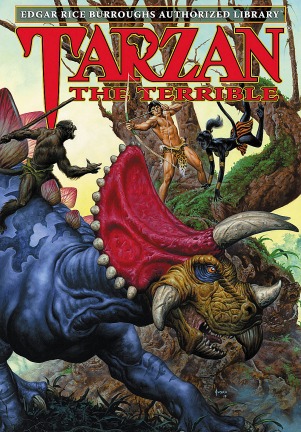
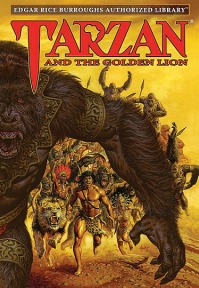
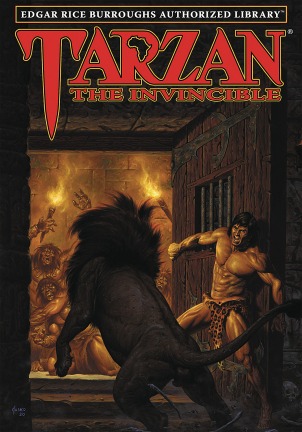
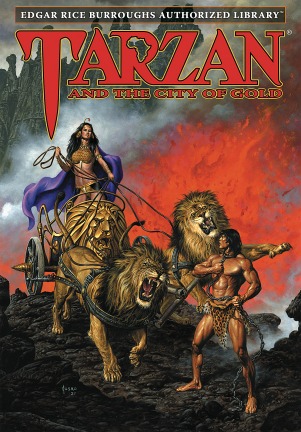


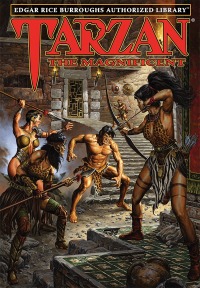
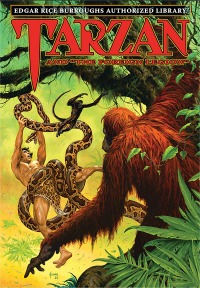
The Young
Tarzan Almost Killed a Woman
That
brings us back to the
original
question. Did Tarzan of the Apes, despite all his denials that he
could, ever
kill a woman during ERB’s chronicles of the ape-man?
Well,
very early in his life he
was more
than ready to do so. In Tarzan of the
Apes, he was within seconds of stabbing to death a native woman
in
Mbonga’s
village. He was rummaging around in a native hut looking for something
to use
in a prank against the superstitious tribe, when a native woman
unexpectedly
entered the hut.
“Tarzan
drew back silently to the far wall, and his hand sought the long, keen
hunting
knife of his father. The woman came quickly to the center of the hut.
There she
paused for an instant feeling about with her hands for the thing she
sought.
Evidently it was not in its accustomed place, for she explored ever
nearer and
nearer the wall where Tarzan stood.
“So
close was she now that the ape-man felt the animal warmth of her naked
body. Up
went the hunting knife, and then the woman turned to one side and soon
a
guttural ‘ah’ proclaimed that her search had at last been successful.
Immediately she turned and left the hut …”
Raised
as he was in the wild,
it could have
been considered a natural act of survival for him to kill a native
woman. But
when he merged with the civilized world at age 21, he accepted its
general convention
that men are protectors of woman.
So,
we return again to the
initial
question: Did Tarzan ever kill a woman?
The answer is “yes.” Tarzan did kill a woman in the stories ERB
told of
the ape-man. In fact, he did it twice!
Tarzan
Kills His First Woman
The
first time was durinan
encounter with
an Alalus woman in Tarzan
and the Ant
Men. After his plane crashed inside the Great Thorn
Forest,
Tarzan
soon
encountered the Alalus people. According to ERB, “The hideous life of
the
Alalus was the natural result of the unnatural reversal of sex
dominance.” The
physically stronger females saw males as no more than reproductive
tools.
Unconscious
after the plane
crash, Tarzan
was “picked up” by a female Alalus and confined in a village corral.
Later, he
was threatened by an Alalus girl. The encounter tested Tarzan’s
assertion that
he could never kill a woman.
“And
now the girl was almost upon them. Tarzan was quite at a loss as to how
to
proceed against her. His natural chivalry restrained him from attacking
her and
made it seem most repellant to injure her even in self-preservation;
but he
knew that before he was done with her he might even possibly have to
kill her
and so, while looking for an alternative, he steeled himself for the
deed he
loathed; but yet he hoped to escape without that.”
Tarzan
side-stepped the situation when he and
an Alalus boy fled over the corral wall and escaped into the jungle.
Later,
though, Tarzan’s vow that he could not kill a woman was put to the
ultimate
challenge. Tarzan chose to intervene when an Alalus woman grabbed a
diminutive
“Minunian” man. The ape-man warned the woman to release her captive and
go
away. Instead, though, she raised her bludgeon and advanced toward
Tarzan, who
then fitted an arrow to his bow.
“‘Go
back’ he signed her. ‘Go back, or I will kill you. Go back, and put
down the
little man.’ She snarled ferociously and increased her pace. Tarzan
raised the
arrow to the level of his eye and drew it back until the bow bent … The
ape-man
hoped that the woman would obey his commands before he was compelled to
take
her life, but even a cursory glance at her face revealed anything but
an
intention to relinquish her purpose, which now seemed to be to
annihilate this
presumptuous meddler as well.
“On
she came. Already she was too close to make further delay safe and the
ape-man
released his shaft. Straight into her savage heart it drove and as she
stumbled
forward Tarzan leaped to meet her, seizing the warrior from her grasp
before
she might fall upon the tiny body and crush it.”
In
assessing this particular
situation, a
previous assertion by Tarzan should be recalled. The ape-man’s most
recent
statement on the issue was conditional. In Tarzan
and the Golden Lion,
the
ape-man told La, “I cannot kill a woman.
Tarzan of
the Apes kills only in self-defense and for food, or when there is no
other way
to thwart an enemy.”
Certainly, he warned the Alalus women with hand
signals,
voice commands, and actions that he would kill her if needed to protect
himself.
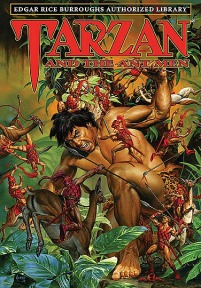
Tarzan
Kills Another Woman
The
second incident involving
Tarzan
killing a woman occurred in Tarzan and
the Leopard Men. At one point, toward the end of the story, an
American
girl, Jessie Jerome (aka “Kali Bwana”)
was being held captive in a
pygmy tribe
village. When the tribe eventually decided to kill and eat Jessie,
Wlala, a
pygmy woman who was Jessie’s guard, volunteered to kill her.
Just
as Wlala grabbed Jessie by
the hair
and raised a knife to slay her, Tarzan arrived in the nick of time to
save
Jessie.
“To a
tree Tarzan made his way, keeping the bole of it between him and the
natives
assembled about the fires; and into its branches he swung just in time
to see
Wlala seize the girl by the hair and lift her blade to slash the fair
throat.
There was no time for thought, barely time for action. The muscles of
the
ape-man responded almost automatically to the stimulus of the
necessity. To fit
an arrow to his bow and to loose the shaft required but the fraction of
a split
second.”
As
described by ERB, the arrow
“passed
through the body of Wlala from behind, transfixing her heart.”
In
that situation, Tarzan
killed one woman
to save the life of another woman. In all honesty, though, the race of
the
woman Tarzan killed in that situation was the determining factor in the
ape-man’s
decision. Would Tarzan have reacted with lethal force, if a white woman
were
about to kill a pygmy woman? It’s a fool’s question, of course, as
Burroughs
would never have considered such a scenario.

THE END



![]()

![]()
BILL
HILLMAN
Visit
our thousands of other sites at:
BILL
and SUE-ON HILLMAN ECLECTIC STUDIO
ERB
Text, ERB Images and Tarzan® John Carter® Priness of Mars®
are ©Edgar Rice Burroughs, Inc.- All Rights Reserved.
All
Original Work ©1996-2025 by Bill Hillman and/or Contributing
Authors/Owners
No
part of this web site may be reproduced without permission from the
respective
owner.